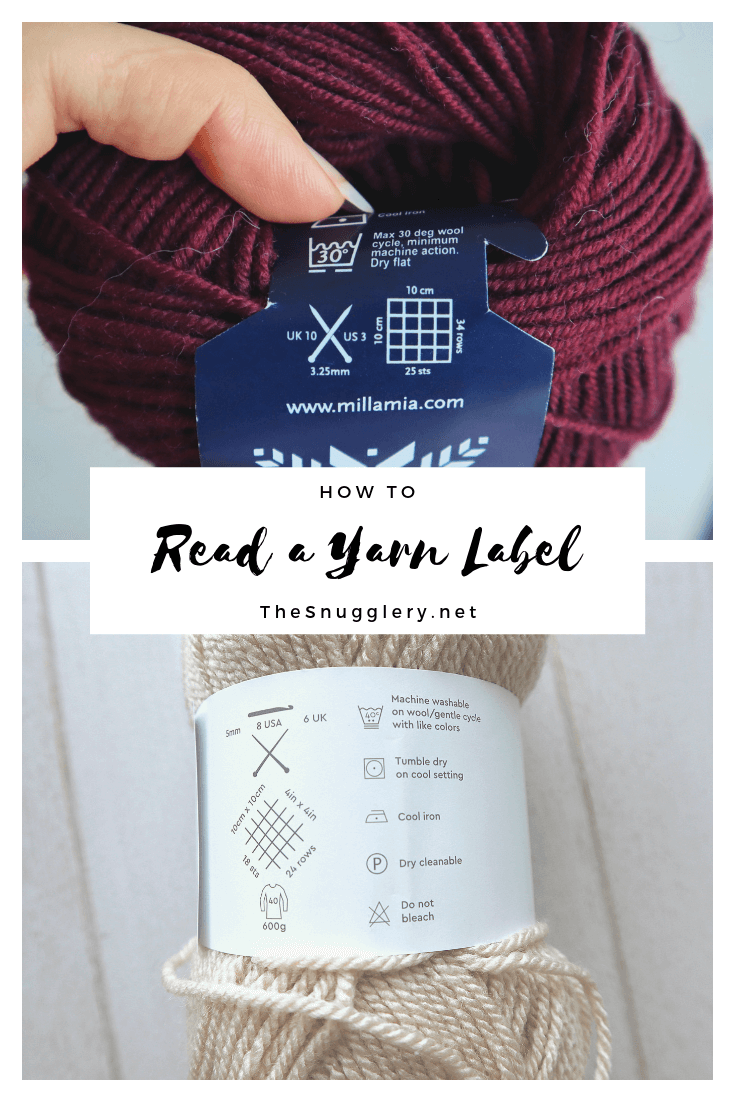You might have made it a habit to ignore the back of your yarn label. I can't blame you for glazing over at the sight of all those numbers and symbols. But maybe you've heard someone mention "dye lots" or "gauge" and can't help but feel like there's some info you're missing out on. This post will detail the 7 attributes that will help make sense of it all so you can learn how to read a yarn label and get the most out of it!
Keep in mind, labels from different companies look a little different.
So let's get into some of the "Whats" and "Whys" of yarn labeling.
1. Fiber content
This is where you'll find the list of fibers in your yarn and their percentages. I make sure to always check out this part of the yarn label. It can help you figure out if the yarn contains fibers you're sensitive to and in what concentration. For example: Wool-Ease Thick & Quick might scare off some wool sensitive yarnies out there but it actually only contains 20% wool. (I'm sensitive to wool but 20% or less doesn't bother me). So don't necessarily poo-poo a yarn you think you can't use...check that label!
2. Length and weight
These metrics are important when you're following patterns. Often, patterns will either give you the yarn amount requirements in weight or length and not number of balls. So whip out your phone calculator and use the yarn label to figure out how many balls to buy for your pattern.
Just a quick example: If your pattern requires 350 yards and the yarn balls have 100 yards each, you'll want to pick up at least 4 balls to have enough for your pattern with a little left over.
3. Gauge information
This includes the recommended knitting needle size and often the recommended crochet hook size as well as a typical "gauge" when working a 4in x 4in (10cm x 10cm) swatch. Usually that's stockinette for knitting and single crochet for crocheting. (Honestly, this topic probably deserves a blog post all to itself).
It's useful to see if the yarn will work for a particular pattern. If the gauge on the ball is similar to the gauge in the pattern with the same needle size, it's likely the yarn will suit your pattern. Can you stray from the recommended needle size? Absolutely! Some patterns may even suggest it. But it's nice to have a ballpark needle size for the yarn weight, especially for beginners.
4. Yarn weight category
This will be a number between 0-7 written in a little black and white yarn ball.
These are the Craft Yarn Council's standards and each number corresponds with a handful of terms that can vary depending on where your yarn is from. For example: Chunky/Bulky = 5, Worsted/Aran = 4, DK/Light = 3. Check out this resource from the Craft Yarn Council for an informative breakdown!
5. Where it's made
Just some fun FYI. Ever notice how many yarns are made in Turkey?
6. Care information
This is where you'll find in words and/or symbols how to care for your finished objects made with the yarn. Some wools can withstand a good wash and dry, some synthetics can't! So be sure to check this part of the label and familiarize yourself with the laundry care symbols you can find here.
7. Yarn color and dye lot
All the yarn with the same dye lot were made at the same time so there will be no variation in the color from ball to ball. Sometimes you can tell the difference between dye lots on projects once they're worked up. It looks like a line on your blanket or sweater where you can see a slight shade change. So to avoid that, make sure to check your dye lot and get enough skeins to finish your project.

